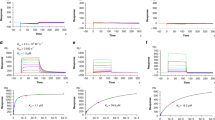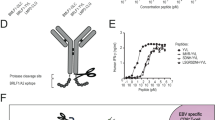Abstract
Although several clinical trials have shown beneficial effects by targeting tumor-associated antigens (TAAs) with monoclonal antibodies, a number of issues, including poor penetration of the tumor mass and human antimouse antibody responses, remain. The use of recombinant single-chain Fv (scFv) fragments has the potential to address these and other issues while allowing the addition of different effector functions. To develop therapeutic strategies that recruit both humoral and cellular arms of the immune response, we have constructed chimeric proteins linking either the human IgG1 Fc domain or the extracellular domain of murine B7.1 to a scFv specific for the oncofetal glycoprotein, 5T4. This TAA is expressed by a wide variety of carcinomas and is associated with metastasis and poorer clinical outcome. We have engineered retroviral constructs that produce fusion proteins able to interact simultaneously with both 5T4-positive cells and with the receptor/ligands of the immune effector moieties. Genetic delivery through a murine leukemia virus vector to 5T4-positive tumor cells results in the secreted scFv fusion protein binding to the cell surface. Furthermore, the scFv–HIgG1 fusion protein is able to direct lysis of 5T4-expressing human tumor cell lines through antibody-dependent cell cytotoxicity, indicating its potential as a gene therapy for human cancers.
This is a preview of subscription content, access via your institution
Access options
Subscribe to this journal
Receive 12 print issues and online access
$259.00 per year
only $21.58 per issue
Buy this article
- Purchase on Springer Link
- Instant access to full article PDF
Prices may be subject to local taxes which are calculated during checkout










Similar content being viewed by others
References
Durrant LG, Maxwell-Armstrong C, Buckley D et al. A neoadjuvant clinical trial in colorectal cancer patients of the human anti-idiotypic antibody 105AD7, which mimics CD55 Clin Cancer Res 2000 6: 422–430
Foran JM, Rohatiner AZ, Cunningham D et al. European phase II study of rituximab (chimeric anti-CD20 monoclonal antibody) for patients with newly diagnosed mantle-cell lymphoma and previously treated mantle-cell lymphoma, immunocytoma, and small B-cell lymphocytic lymphoma J Clin Oncol 2000 18: 317–324
Riethmuller G, Holz E, Schlimok G et al. Monoclonal antibody therapy for resected Dukes' C colorectal cancer: seven-year outcome of a multicenter randomized trial J Clin Oncol 1998 16: 1788–1794
Divgi CR, Scott AM, Dantis L et al. Phase I radioimmunotherapy trial with iodine-131-CC49 in metastatic colon carcinoma J Nucl Med 1995 36: 586–592
Zeng ZC, Tang ZY, Liu KD, Lu JZ, Xie H, Yao Z . Improved long-term survival for unresectable hepatocellular carcinoma (HCC) with a combination of surgery and intrahepatic arterial infusion of 131I–anti-HCC mAb. Phase I/II clinical trials J Cancer Res Clin Oncol 1998 124: 275–280
Appelbaum FR . Antibody-targeted therapy for myeloid leukemia Semin Hematol 1999 36: 2–8
Sliwkowski MX, Lofgren JA, Lewis GD, Hotaling TE, Fendly BM, Fox JA . Nonclinical studies addressing the mechanism of action of trastuzumab (Herceptin) Semin Oncol 1999 26: 60–70
Tse E, Rabbitts TH . Intracellular antibody-caspase–mediated cell killing: an approach for application in cancer therapy Proc Natl Acad Sci USA 2000 97: 12266–12271
Gutheil JC, Campbell TN, Pierce PR et al. Targeted antiangiogenic therapy for cancer using Vitaxin: a humanized monoclonal antibody to the integrin alphavbeta3 Clin Cancer Res 2000 6: 3056–3061
Vollmers HP, Zimmermann U, Krenn V et al. Adjuvant therapy for gastric adenocarcinoma with the apoptosis-inducing human monoclonal antibody SC-1: first clinical and histopathological results Oncol Rep 1998 5: 549–552
Cooley S, Burns LJ, Repka T, Miller JS . Natural killer cell cytotoxicity of breast cancer targets is enhanced by two distinct mechanisms of antibody-dependent cellular cytotoxicity against LFA-3 and HER2/neu Exp Hematol 1999 27: 1533–1541
Grillo-Lopez AJ, White CA, Varns C et al. Overview of the clinical development of rituximab: first monoclonal antibody approved for the treatment of lymphoma Semin Oncol 1999 26: 66–73
Sharkey RM, Gold DV, Aninipot R et al. Comparison of tumor targeting in nude mice by murine monoclonal antibodies directed against different human colorectal cancer antigens Cancer Res 1990 50: 828s–834s
Yokota T, Milenic DE, Whitlow M, Schlom J . Rapid tumor penetration of a single-chain Fv and comparison with other immunoglobulin forms Cancer Res 1992 52: 3402–3408
Khazaeli MB, Conry RM, LoBuglio AF . Human immune response to monoclonal antibodies J Immunother 1994 15: 42–52
Adams GP, McCartney JE, Tai MS et al. Highly specific in vivo tumor targeting by monovalent and divalent forms of 741F8 anti–c-erbB-2 single-chain Fv Cancer Res 1993 53: 4026–4034
Milenic DE, Yokota T, Filpula DR et al. Construction, binding properties, metabolism, and tumor targeting of a single-chain Fv derived from the pancarcinoma monoclonal antibody CC49 Cancer Res 1991 51: 6363–6371
Clark MR . IgG effector mechanisms Chem Immunol 1997 65: 88–110
Boussiotis VA, Freeman GJ, Gribben JG, Nadler LM . The role of B7-1/B7-2:CD28/CLTA-4 pathways in the prevention of anergy, induction of productive immunity and down-regulation of the immune response Immunol Rev 1996 153: 5–26
Griffiths L, Binley K, Iqball S et al. The macrophage — a novel system to deliver gene therapy to pathological hypoxia Gene Ther 2000 7: 255–262
Whittington HA, Ashworth LJ, Hawkins RE . Recombinant adenoviral delivery for in vivo expression of scFv antibody fusion proteins Gene Ther 1998 5: 770–777
Hu Z, Garen A . Intratumoral injection of adenoviral vectors encoding tumor-targeted immunoconjugates for cancer immunotherapy Proc Natl Acad Sci USA 2000 97: 9221–9225
Cochet O, Kenigsberg M, Delumeau I et al. Intracellular expression of an antibody fragment-neutralizing p21 ras promotes tumor regression Cancer Res 1998 58: 1170–1176
Myers KA, Rahi-Saund V, Davison MD, Young JA, Cheater AJ, Stern PL . Isolation of a cDNA encoding 5T4 oncofetal trophoblast glycoprotein. An antigen associated with metastasis contains leucine-rich repeats J Biol Chem 1994 269: 9319–9324
Hole N, Stern PL . A 72 kD trophoblast glycoprotein defined by a monoclonal antibody Br J Cancer 1988 57: 239–246
Hole N, Stern PL . Isolation and characterization of 5T4, a tumour-associated antigen Int J Cancer 1990 45: 179–184
Southall PJ, Boxer GM, Bagshawe KD, Hole N, Bromley M, Stern PL . Immunohistological distribution of 5T4 antigen in normal and malignant tissues Br J Cancer 1990 61: 89–95
Jones H, Roberts G, Hole N, McDicken IW, Stern P . Investigation of expression of 5T4 antigen in cervical cancer Br J Cancer 1990 61: 96–100
Wrigley E, McGown A, Rennison J et al. 5T4 oncofetal antigen expression in ovarian carcinoma Int J Gynecol Cancer 1995 5: 269–274
Starzynska T, Rahi V, Stern PL . The expression of 5T4 antigen in colorectal and gastric carcinoma Br J Cancer 1992 66: 867–869
Starzynska T, Marsh PJ, Schofield PF, Roberts SA, Myers KA, Stern PL . Prognostic significance of 5T4 oncofetal antigen expression in colorectal carcinoma Br J Cancer 1994 69: 899–902
Forsberg G, Ohlsson L, Brodin T et al. Therapy of human non-small-cell lung carcinoma using antibody targeting of a modified superantigen Br J Cancer 2001 85: 129–136
Shaw DM, Embleton MJ, Westwater C et al. Isolation of a high affinity scFv from a monoclonal antibody recognising the oncofoetal antigen 5T4 Biochim Biophys Acta 2000 1524: 238–246
Landau NR, Littman DR . Packaging system for rapid production of murine leukemia virus vectors with variable tropism J Virol 1992 66: 5110–5113
Soneoka Y, Cannon PM, Ramsdale EE et al. A transient three-plasmid expression system for the production of high titer retroviral vectors Nucleic Acids Res 1995 23: 628–633
Nambu M, Morita M, Watanabe H et al. Regulation of Fc gamma receptor expression and phagocytosis of a human monoblast cell line U937. Participation of cAMP and protein kinase C in the effects of IFN-gamma and phorbol ester J Immunol 1989 143: 4158–4165
Primus FJ, Finch MD, Masci AM, Schlom J, Kashmiri SV . Self-reactive antibody expression by human carcinoma cells engineered with monoclonal antibody genes Cancer Res 1993 53: 3355–3361
Roovers RC, Henderikx P, Helfrich W et al. High-affinity recombinant phage antibodies to the pan-carcinoma marker epithelial glycoprotein-2 for tumour targeting Br J Cancer 1998 78: 1407–1416
Velders MP, van Rhijn CM, Oskam E, Fleuren GJ, Warnaar SO, Litvinov SV . The impact of antigen density and antibody affinity on antibody-dependent cellular cytotoxicity: relevance for immunotherapy of carcinomas Br J Cancer 1998 78: 478–483
Townsend SE, Allison JP . Tumor rejection after direct costimulation of CD8+ T cells by B7-transfected melanoma cells Science 1993 259: 368–370
Baskar S, Ostrand-Rosenberg S, Nabavi N, Nadler LM, Freeman GJ, Glimcher LH . Constitutive expression of B7 restores immunogenicity of tumor cells expressing truncated major histocompatibility complex class II molecules Proc Natl Acad Sci USA 1993 90: 5687–5690
Chen L, McGowan P, Ashe S et al. Tumor immunogenicity determines the effect of B7 costimulation on T cell–mediated tumor immunity J Exp Med 1994 179: 523–532
Carroll MW, Overwijk WW, Surman DR, Tsung K, Moss B, Restifo NP . Construction and characterization of a triple-recombinant vaccinia virus encoding B7-1, interleukin 12, and a model tumor antigen J Natl Cancer Inst 1998 90: 1881–1887
Gilligan MG, Knox P, Weedon S et al. Adenoviral delivery of B7-1 (CD80) increases the immunogenicity of human ovarian and cervical carcinoma cells Gene Ther 1998 5: 965–974
Holliger P, Manzke O, Span M et al. Carcinoembryonic antigen (CEA)–specific T-cell activation in colon carcinoma induced by anti-CD3×anti-CEA bispecific diabodies and B7×anti-CEA bispecific fusion proteins Cancer Res 1999 59: 2909–2916
Ragnhammar P, Frodin J-E, Hjelm A-L et al. Different dose regimens of the mouse monoclonal antibody 17-1A for therapy of patients with metastatic colorectal carcinoma Int J Oncol 1995 7: 1049–1056
Juweid ME, Hajjar G, Swayne LC et al. Phase I/II trial of (131)I-MN-14F(ab)2 anti-carcinoembryonic antigen monoclonal antibody in the treatment of patients with metastatic medullary thyroid carcinoma Cancer 1999 85: 1828–1842
LoBuglio AF, Wheeler RH, Trang J et al. Mouse/human chimeric monoclonal antibody in man: kinetics and immune response Proc Natl Acad Sci USA 1989 86: 4220–4224
Gruber R, van Haarlem LJ, Warnaar SO, Holz E, Riethmuller G . The human antimouse immunoglobulin response and the anti-idiotypic network have no influence on clinical outcome in patients with minimal residual colorectal cancer treated with monoclonal antibody CO17-1A Cancer Res 2000 60: 1921–1926
Clark JI, Alpaugh RK, von Mehren M et al. Induction of multiple anti–c-erbB-2 specificities accompanies a classical idiotypic cascade following 2B1 bispecific monoclonal antibody treatment Cancer Immunol Immunother 1997 44: 265–272
Sacchi S, Federico M, Dastoli G et al. Treatment of B-cell non-Hodgkin's lymphoma with anti CD 20 monoclonal antibody Rituximab Crit Rev Oncol Hematol 2001 37: 13–25
Huls GA, Heijnen IA, Cuomo ME et al. A recombinant, fully human monoclonal antibody with antitumor activity constructed from phage-displayed antibody fragments Nat Biotechnol 1999 17: 276–281
Author information
Authors and Affiliations
Corresponding author
Rights and permissions
About this article
Cite this article
Myers, K., Ryan, M., Stern, P. et al. Targeting immune effector molecules to human tumor cells through genetic delivery of 5T4-specific scFv fusion proteins. Cancer Gene Ther 9, 884–896 (2002). https://doi.org/10.1038/sj.cgt.7700513
Received:
Published:
Issue Date:
DOI: https://doi.org/10.1038/sj.cgt.7700513
Keywords
This article is cited by
-
5T4-specific chimeric antigen receptor modification promotes the immune efficacy of cytokine-induced killer cells against nasopharyngeal carcinoma stem cell-like cells
Scientific Reports (2017)
-
Adoptive immunotherapy using human peripheral blood lymphocytes transferred with RNA encoding Her-2/neu-specific chimeric immune receptor in ovarian cancer xenograft model
Cancer Gene Therapy (2009)
-
Active treatment of murine tumors with a highly attenuated vaccinia virus expressing the tumor associated antigen 5T4 (TroVax) is CD4+ T cell dependent and antibody mediated
Cancer Immunology, Immunotherapy (2006)
-
In vivo evaluation of an EIAV vector for the systemic genetic delivery of therapeutic antibodies
Gene Therapy (2005)
-
Improved gene transfer selectivity to hepatocarcinoma cells by retrovirus vector displaying single-chain variable fragment antibody against c-Met
Cancer Gene Therapy (2003)



